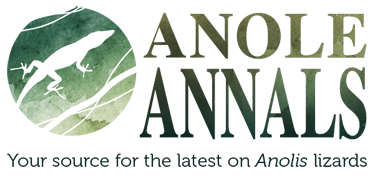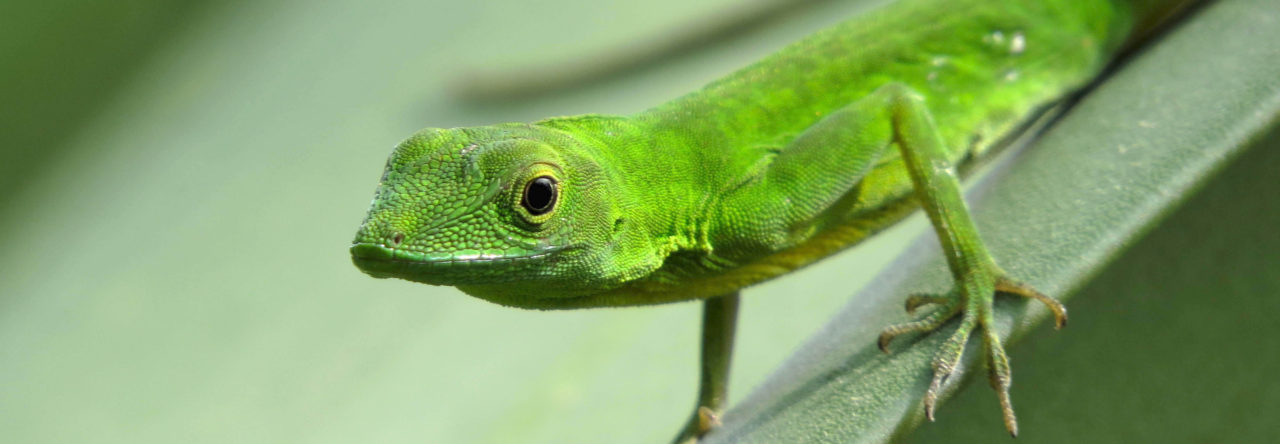Author: Jonathan Losos Page 117 of 131
Professor of Biology and Director of the Living Earth Collaborative at Washington University in Saint Louis. I've spent my entire professional career studying anoles and have discovered that the more I learn about anoles, the more I realize I don't know.
 Who could turn down a good looker with something upstairs, especially wearing a gorgeous shade of green? Not the Economist, which featured Leal and Powell’s study of anole cognition in this week’s edition (no, it’s not the article on the orgasmatron). See the article here.
Who could turn down a good looker with something upstairs, especially wearing a gorgeous shade of green? Not the Economist, which featured Leal and Powell’s study of anole cognition in this week’s edition (no, it’s not the article on the orgasmatron). See the article here.
In fact, anole-o-mania has caught on, with reports in print, online, and on radio and TV. Most recent is today’s piece in the Science Times.
According to the Life Science Log, this is among the most cited news reports in the last week. For a full list of media coverage–with more still on the way–check here.
Bonus points: who remembers the orgasmatron?
p.s. A video of the lizards problem-solving is now available on YouTube
Ever try playing softball after a barbecue? Doesn’t work so well, does it? Now imagine trying the long jump–just the thought makes me a little queasy. But animals in the wild have to do this all the time. Does it affect their performance? Lizards and other animals are known to have their running abilities diminished by carrying a large load, such as a meal or eggs, but no one previously has looked at the effect of increased weight on jumping.
Until now. In a recent paper, Kuo et al. increased the weight of green anoles 30% by wrapping a weighted cloth around their midsection and then induced them to jump (pdf of the paper here). As a control, they wrapped light paper around the lizard in the same manner. As you might expect, the encumbered anoles were less proficient leapers; jump distance declined 18% and takeoff speed 10%. However, their accuracy, as judged by ability to land on a target, was not affected.
More than two years post-publication, reviews of Lizards in an Evolutionary Tree continue to trickle in. The most recent appeared in Austral Ecology and Herpetological Review. See all 12 (of which we’re aware–know of others?) here.
I have long thought that the Asian lacertid lizard, Takydromus sexlineatus, is the best example of a non-anole species that corresponds to one of the anole ecomorphs. Extraordinarily long in tail, slender in body, light brown in color with a light-colored lateral stripe, this grass-dwelling lizard seems a dead ringer to a grass-bush ecomorph. This, of course, leads to many questions, not least of which is: if Takydromus somehow were juxtaposed with some ecomorphs, how would they interact? Now we know the answer.
They’d ignore each other. Or at least, they’d do so within the confines of a small
Petsmart vivarium where they are commonly sold.
 Manuel Leal and Brian Powell have just published a paper in Biology Letters demonstrating that lizards are smart. Before getting to the details, though—here’s the important point: check out the videos! They’re pretty amazing (here, scroll down and click on the videos).
Manuel Leal and Brian Powell have just published a paper in Biology Letters demonstrating that lizards are smart. Before getting to the details, though—here’s the important point: check out the videos! They’re pretty amazing (here, scroll down and click on the videos).
Here’s the story: working with the Puerto Rican trunk-crown anole, A. evermanni, Leal and Powell presented lizards with an experimental apparatus in their home cages with two wells, in one of which was a dead phoenix worm (whatever that is). Next to the well with the worm was a little round disc similar to a poker chip. The lizards learned to go to the well and find and eat the worms. Then the experimenters placed the chip halfway over the well. Again, no problem.
Now comes the cool part. The experimenters completely covered the well containing the worm with a blue chip. Remember, these are Anolis lizards that usually find their prey by looking for movement—they don’t go digging around in the underbrush. Still, four out of the six lizards figured out how to get the mealworm: two of them bit the chip and removed it from covering the well, while two others figured out how to use their snouts as a lever to flip the chip off the well. This is pure problem-solving, and it uses novel behaviors, rather than simply transferring a natural behavior to a new context! And the two lizards that failed to get the worm came up with their own solution, hitting the center of the chip with their snout—but this was ineffective in dislodging the chip.
Once the lizards had learned to find the worm under the chip, the experimenters then conducted a discrimination trial, giving the choice of a blue chip and a yellow chip. Without error, the lizards always went to the blue chip; subsequently, they were presented a blue chip versus a blue-and-yellow chip, and they still had no problem.
Pretty amazing for a lizard, if you ask me, but it gets even better.
 Check it out. Read the backstory here.
Check it out. Read the backstory here.
In the last two days, I have received email requests from researchers studying various aspects of anole genomics, one asking for whole genomic DNA from A. carolinensis and the other for material derived from A. carolinensis embryos. These particular researchers are interested in, respectively, promoter elements in opsin genes and cerebral cortex development in the brain, with a particular interest in comparing brain transcriptomes from different species. I have received a number of similar requests in the last few months.
With the sequencing of the A. carolinensis, the first reptile to be sequenced, anoles are now on the radar screen of the comparative genomics community. This is a great thing both for understanding how genomes evolve in general, but also for how anoles evolve specifically. No doubt, this is the dawn of an exciting age in anole biology.
But these requests will no doubt continue to roll in, probably in increasing numbers. And, unlike many “model” organisms, there are not (at least not yet) anole stock centers or other resources to get the material needed for all kinds of studies. Providing genomic DNA is a trivial enterprise, and those of us doing relevant work should probably expect and be prepared for requests like these. But producing embryos for all kinds of developmental/genetic questions is another matter. There will be a need for material from anoles–initially A. carolinensis, but eventually others–at all life stages. We probably can’t expect genomicists to set up their own facilities to produce eggs and offspring (though maybe I don’t give them enough credit). My guess is that in the short term, it will fall on the anole community to provide this material.
Read all about them here.






